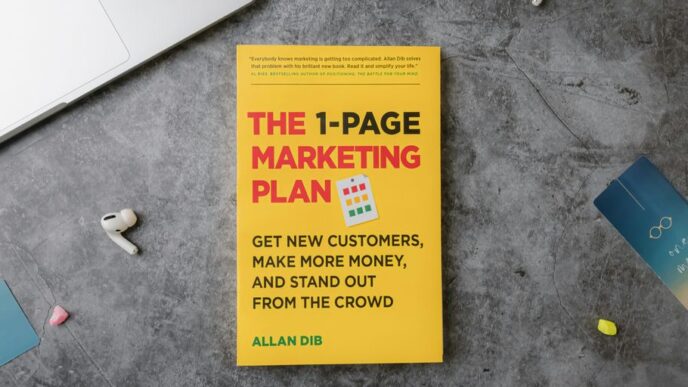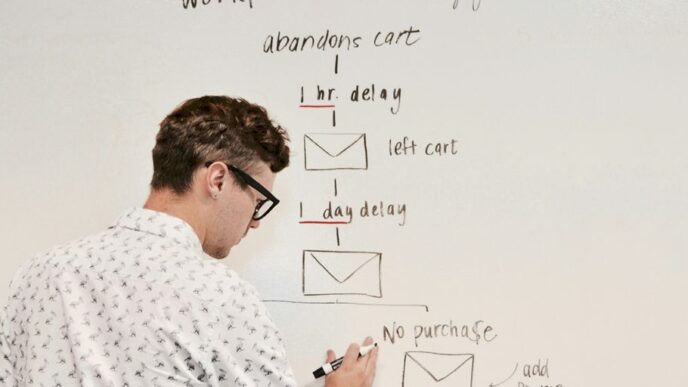Creating a successful 360 marketing campaign in 2025 may seem daunting, but it really boils down to one key principle: connecting with your audience at every touchpoint. Whether it’s through social media, email, or even traditional methods like flyers, the aim is to create a cohesive experience. This guide will walk you through the essential steps to design a campaign that resonates with your customers and drives results.
Key Takeaways
- A 360 marketing campaign delivers a unified message across all platforms, ensuring customers receive consistent information.
- Understanding your audience through data is vital for creating a campaign that resonates and engages.
- Regularly measuring your campaign’s performance allows for adjustments that can enhance future marketing efforts.
Understanding the Core Elements of a 360 Marketing Campaign
Defining a 360 Marketing Campaign
Okay, so what is a 360 marketing campaign? It’s more than just being on every platform. It’s about creating a complete experience for your customer. Think of it as surrounding them with your brand, but in a way that feels natural, not overwhelming. It’s about making sure your message is consistent, no matter where someone encounters your brand. For example, if you’re running a campaign for a new line of organic snacks, your Instagram posts might focus on the fun, colorful packaging, while your email campaign could highlight the health benefits. The core message – healthy and delicious – stays the same.
Key Differences Between 360 and Multi-Channel Marketing
Multi-channel marketing is like having a bunch of different conversations happening at once. Each channel operates independently. A 360 campaign is different. It’s about making sure all those conversations are connected. Imagine a store having a sale. In a multi-channel approach, they might post about it on Facebook and send out an email. In a 360 campaign, they’d also update their website banner, have in-store signage, and maybe even run a targeted ad campaign based on website visitors. It’s all connected, creating a cohesive experience. Here’s a quick breakdown:
- Multi-channel: Separate teams, separate strategies.
- 360: Integrated teams, unified strategy.
- Multi-channel: Focus on individual platform performance.
- 360: Focus on overall customer experience.
The Role of Consistent Messaging Across Platforms
Why is consistent messaging so important? Because it builds trust. If someone sees one message on your website and a completely different one on your social media, they’re going to be confused. And confused customers don’t buy things. It’s not about repeating the exact same words everywhere. It’s about making sure the core message is the same, even if the delivery is different. Think of it like this:
- Website: Detailed product descriptions, benefits, and features.
- Social Media: Engaging visuals, short and sweet captions.
- Email: Personalized offers, customer stories.
The message is always consistent, but the way it’s delivered is tailored to the platform. This helps to create a strong brand identity and makes your marketing efforts more effective.
Measuring Success in a 360 Marketing Campaign
Setting Clear and Measurable Goals
Okay, so you’re putting all this effort into a 360 marketing campaign. How do you know if it’s actually working? First, you gotta figure out what you want to achieve. Don’t just say you want more customers. Get real specific. Maybe you want to see a 30% jump in website visits, or get 500 new folks to sign up for your email list. Whatever it is, make sure you can actually measure it. Numbers don’t lie. They tell you if you’re on the right track or if you need to switch things up. And make sure these goals line up with what your business is trying to do overall. A 360 campaign is a big deal, so your goals should match that.
Tracking Performance Across Channels
Running a campaign on a bunch of different platforms – social media, email, ads – can get messy fast. It’s easy to lose sight of what’s doing well and what’s flopping. That’s where performance tracking tools come in handy. Use analytics to keep an eye on things like:
- Click-through rates
- How many people are buying stuff
- How much people are interacting with your content
Don’t just look at the numbers, though. Think about what they mean. If your emails are getting opened a lot, but nobody’s clicking on the links, maybe your subject lines are great, but the stuff inside needs work. Check your data regularly so you can spot trends and make changes as you go.
Using Data to Refine Future Campaigns
Data isn’t just for patting yourself on the back (or kicking yourself). It’s there to help you do better next time. Once your campaign is done, really dig into the results. Did you hit your goals? If not, why not? Maybe your message didn’t connect with people, or you were focusing on the wrong places. Use what you learn to make your next campaign better. And don’t be scared to try new things. Marketing is about learning from your mistakes just as much as it is about celebrating your wins. Over time, these lessons will make your 360 campaigns way more effective.
Crafting a Data-Driven 360 Marketing Strategy

The Importance of Audience Insights
Okay, so you want your 360 marketing to actually, you know, work? Then you gotta know who you’re talking to. It’s not rocket science, but it’s surprising how many people skip this step. Audience insights are the bedrock of any effective marketing strategy, especially when you’re trying to hit all the angles with a 360 campaign.
Think about it: you wouldn’t cook a meal without knowing who you’re cooking for, right? Same deal here. Start digging into the data. Who are these people? What do they like? What makes them tick? Where do they hang out online? You can use all sorts of tools to get this info, like:
- Surveys: Ask them directly! You’d be surprised how willing people are to share their opinions.
- Social media analytics: See what they’re talking about, what they’re sharing, and who they’re following. Social media analytics can be a goldmine of information.
- Customer feedback: Read reviews, listen to customer service calls, and pay attention to what people are saying about your brand.
Once you’ve got a good handle on your audience, break them down into smaller groups based on shared traits. This way, you can tailor your message to each group and make sure it really hits home.
Leveraging Analytics for Campaign Optimization
Data is your friend. Seriously. It’s not just a bunch of numbers; it’s a roadmap to success. You need to use analytics to see how your campaign is doing across all those different channels. Are people clicking on your ads? Are they opening your emails? Are they actually buying anything? If not, why not?
Platforms like Google Analytics are your best friends here. They can give you tons of info about what’s working and what’s not. Look at things like:
- Engagement rates: How many people are liking, sharing, and commenting on your content?
- Conversion rates: How many people are actually turning into customers?
- Customer retention: Are people sticking around after they make a purchase?
The key is to be flexible and make changes based on what the data tells you. If something’s not working, don’t be afraid to ditch it and try something new. Marketing is all about experimenting and finding what works best for your audience. It’s a constant process of tweaking and optimizing. Don’t be afraid to adjust your strategy accordingly.
Balancing Personalization with Privacy
Okay, so personalization is great. People love it when you send them stuff that’s relevant to their interests. But there’s a line, right? Nobody wants to feel like they’re being stalked by a brand. You need to be careful about how you use people’s data and make sure you’re respecting their privacy.
Here are a few things to keep in mind:
- Be transparent: Tell people what data you’re collecting and how you’re using it.
- Give people control: Let them opt out of personalization if they want to.
- Don’t be creepy: Avoid using data in ways that feel invasive or intrusive. Think about balancing personalization with privacy.
It’s a tricky balance, but it’s important to get it right. If you respect people’s privacy, they’ll be more likely to trust your brand and engage with your marketing. And that’s what it’s all about, right?
Maximizing Impact Through Channel Integration

Choosing the Right Marketing Channels
Okay, so you’re not going to win if you’re playing the wrong game, right? Same with marketing. You gotta figure out where your people actually are. Are they glued to TikTok? Are they constantly refreshing their LinkedIn feed? Or are they more the type to read email newsletters? Don’t spread yourself thin trying to be everywhere at once. Pick a few spots that make sense for your goals and, honestly, your budget. Like, if you’re trying to reach Gen Z, maybe TikTok marketing is the way to go. But if you’re selling something for professionals, LinkedIn might be a better bet. And think about what you’re selling, too. Got a super visual product? Instagram and Pinterest are your friends. Selling software? Maybe focus on search ads or email campaigns.
Tailoring Content for Platform-Specific Audiences
Here’s the deal: what kills on one platform might totally bomb on another. You wouldn’t post a novel on Twitter, would you? Each platform has its own vibe, so you gotta tweak your stuff to fit in. Instagram? Keep it visual and snappy. LinkedIn? More about thought leadership and professional updates. The goal is to speak the platform’s language while still sounding like your brand. Also, think about how people are using these platforms. People on their phones might want quick videos, while people on desktops might be okay with longer articles. Always test and see what works best.
- Mobile users like short videos.
- Desktop users are okay with longer reads.
- Each platform has its own vibe.
Ensuring Seamless Customer Experiences
Think of your whole campaign as one big trip for your customer. If they click an ad on Facebook and end up on a janky website that takes forever to load, you’ve lost them. Everything needs to flow. Your message, your look, your whole vibe should be the same everywhere. And, super important, make sure your tech works. If someone clicks a link, it should load fast and look good on whatever device they’re using. And don’t forget to follow up! If someone signs up for your newsletter or puts something in their cart, a friendly email reminder can go a long way. Think about customer experiences as a whole.
To really make a difference, it’s important to connect all your channels. When you bring together your online and offline efforts, you can reach more people and create a stronger message. Want to learn more about how to do this? Visit our website for tips and strategies that can help you succeed!
Wrapping It Up
So, there you have it. Crafting a 360 marketing campaign might seem like a lot at first, but it really boils down to connecting with your audience in a genuine way. By using various channels and adjusting your message for each one, you can make sure your brand is present where it matters. The trick is to plan well, keep track of what’s working, and be open to making changes along the way. It’s not about being everywhere all at once; it’s about being in the right spots with the right message. Take it step by step, stay adaptable, and remember: the goal is to create a campaign that feels smooth for your audience and drives results for your business.














